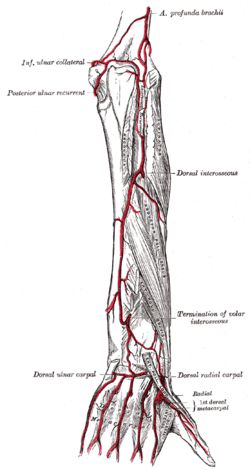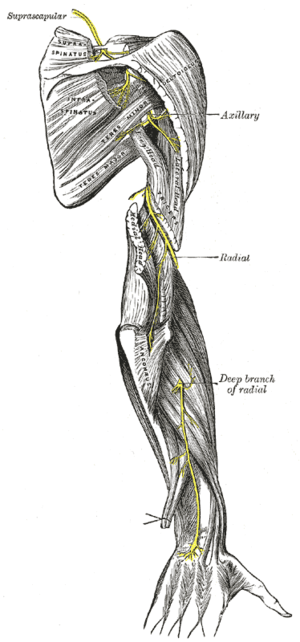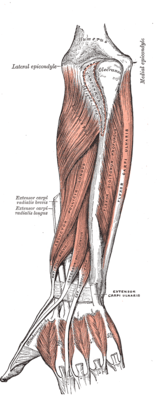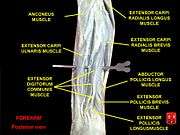Anconeus muscle
The anconeus muscle (or anconaeus/anconæus) is a small muscle on the posterior aspect of the elbow joint.
| Anconeus muscle | |
|---|---|
 Back of right upper extremity. (Anconeus labeled at bottom center.) | |
 Posterior surface of the forearm. Superficial muscles. (Anconeus visible at center right.) | |
| Details | |
| Origin | lateral epicondyle of the humerus proximally |
| Insertion | lateral surface of the olecranon process of the radial and the superior proximal part of the posterior ulna |
| Artery | deep brachial artery, recurrent interosseous artery |
| Nerve | radial nerve (C5, C6, C7, C8, and T1) |
| Actions | It is partly blended in with the triceps, which it assists in extension of the forearm. It also stabilizes the elbow during pronation and supination and pulls slack out of the elbow joint capsule during extension to prevent impingement. |
| Identifiers | |
| Latin | Musculus anconeus, musculus anconaeus |
| TA | A04.6.02.023 |
| FMA | 37704 |
| Anatomical terms of muscle | |
Some consider anconeus to be a continuation of the triceps brachii muscle.[1][2][3] Some sources consider it to be part of the posterior compartment of the arm,[4] while others consider it part of the posterior compartment of the forearm.[5]
The anconeus muscle can easily be palpated just lateral to the olecranon process of the ulna.[6]
Structure
Anconeus originates on the posterior surface of the lateral epicondyle of the humerus and inserts distally on the superior posterior surface of the ulna and the lateral aspect of the olecranon.[6] [7]
Innervation
Anconeus is innervated by a branch of the radial nerve (cervical roots 7 and 8)[7] from the posterior cord of the brachial plexus called the nerve to the anconeus. The somatomotor portion of radial nerve innervating anconeus bifurcates from the main branch in the radial groove of the humerus. This innervation pattern follows the rules of innervation of the musculature of the posterior forearm (extensor) compartment by the radial nerve.
Function


Its role in elbow extension is trivial in humans. It assists in extension of the elbow, where the triceps brachii is the principal agonist, and supports the elbow in full extension.[7] It also prevents the elbow joint capsule being pinched in the olecranon fossa during extension of the elbow. Anconeus also abducts the ulna and stabilizes the elbow joint. Anconeus serves to make minute movements with the radius on the ulna. In making slight abduction of the ulna, it allows any finger to be used as an axis of rotation of the forearm.
Blood supply
Anconeus is supplied by the middle collateral artery from the profunda brachii artery.[7]
Clinical significance
Trauma to the nerve supply of the anconeus muscle can usually result from a shoulder dislocation or fractures of the upper part of the humerus or around the olecranon, or any injury that damages the radial nerve. Harm inflicted upon the radial nerve through these mechanisms can paralyze the anconeus muscle as well as other extensors of the elbow and wrist.[8] There are no specific acquired injuries that exclusively affect the anconeus muscle; however, any disease that compromises muscular functions, particularly arm extension (i.e. muscular dystrophy) will affect this particular accessory muscle. Heterotopic ossification can result from certain trauma as it is an abnormal growth of osseous tissue in non-osseous tissue (e.g. muscle tissue). The condition is usually found in the hips, although there have been documented cases of certain individuals with it occurring in the arms and legs. The cause for the process to initiate is not well understood, only that it typically results from surgery or trauma.[9]
History
Etymology and spelling
Anconeus muscle is the anglicized form of the Latin expression musculus anconaeus, as can be found in the Nomina Anatomica as ratified in Basel in 1895[10] and in Jena in 1935.[11][12] The anatomic Latin adjective anconaeus was written as anconeus in the subsequent edition of the Nomina Anatomica as authorized in 1955 in Paris,[13] without any further explanation of this specific diphthong reduction. The following edition of 1961 specified its policy by stating that: All diphthongs should be eliminated.[14] Although a selected number of monophthongizations was reverted, subsequent editions of the Nomina Anatomica and its most recent outing Terminologia Anatomica insisted on writing musculus anconeus.[14][15][16][17][18] Despite the earlier preference of the Nomina Anatomica for anconaeus no ancient Greek form ἀγκωναῖος is attested.[19] In modern Greek the expression ἀγκωνιαίος μυς[20] is used, with the from anconaeus deviating adjective ἀγκωνιαίος.[21][20]
Anconaeus is derived from the ancient Greek noun, ἀγκών.[22][21] 'Ακών can be translated as bend of the arm [23] or elbow.[22][23] The expression musculus anconaeus was translated into English as elbow muscle in 1907 in the English translation[24] of the first edition of the Nomina Anatomica.
Additional images
 Posterior view of left humerus
Posterior view of left humerus Posterior aspect of bones of left forearm
Posterior aspect of bones of left forearm Deep muscles of posterior surface of the forearm
Deep muscles of posterior surface of the forearm Forearm posterior view
Forearm posterior view- Anconeus muscle
- Anconeus muscle
.jpg) Muscles of upper limb. Cross section.
Muscles of upper limb. Cross section.
References
- Williams, P. et al., 1995, Gray's Anatomy, 38th ed., Churchill Livingstone
- Jones, W. et al. (eds), 1953, Buchanan's Manual of Anatomy, 8th ed., Balliére, Tindall and Cox., pp. 496
- Grant, J. & Basmajian J., 1965, Grant's Method of Anatomy, 7th ed., The Williams & Wilkins Company, Baltimore, pp. 163-164
- "Dissector Answers — Axilla & Arm". Archived from the original on 3 January 2008. Retrieved 2008-01-17.
- "The Radius and Ulna". Archived from the original on 2008-06-11. Retrieved 2008-01-17.
- "Anconeus". Department of Radiology, University of Washington. Archived from the original on 9 October 2017. Retrieved 9 October 2017.
- "Anconeus". The Hosford Muscle Tables. Archived from the original on 2012-02-04. Retrieved 5 February 2012.
- "Archived copy". Archived from the original on 2012-08-29. Retrieved 2012-12-13.CS1 maint: archived copy as title (link)
- http://www.healio.com/orthopedics/journals/ortho/%7B1db95189-cf98-4da1-9b6d-03241994dbcc%7D/treatment-of-heterotopic-ossification
- His, W. (1895). Die anatomische Nomenclatur. Nomina Anatomica. Der von der Anatomischen Gesellschaft auf ihrer IX. Versammlung in Basel angenommenen Namen. Leipzig: Verlag Veit & Comp.
- Kopsch, F. (1941). Die Nomina anatomica des Jahres 1895 (B.N.A.) nach der Buchstabenreihe geordnet und gegenübergestellt den Nomina anatomica des Jahres 1935 (I.N.A.) (3. Auflage). Leipzig: Georg Thieme Verlag.
- Stieve, H. (1949). Nomina Anatomica. Zusammengestellt von der im Jahre 1923 gewählten Nomenklatur-Kommission, unter Berücksichtigung der Vorschläge der Mitglieder der Anatomischen Gesellschaft, der Anatomical Society of Great Britain and Ireland, sowie der American Association of Anatomists, überprüft und durch Beschluß der Anatomischen Gesellschaft auf der Tagung in Jena 1935 endgültig angenommen. (4th edition). Jena: Verlag Gustav Fischer.
- International Anatomical Nomenclature Committee (1955). Nomina Anatomica . London/Colchester:Spottiswoode, Ballantyne and Co. Ltd.
- International Anatomical Nomenclature Committee (1966). Nomina Anatomica. Amsterdam: Excerpta Medica Foundation.
- International Anatomical Nomenclature Committee (1977). Nomina Anatomica, together with Nomina Histologica and Nomina Embryologica. Amsterdam-Oxford: Excerpta Medica.
- International Anatomical Nomenclature Committee (1983). Nomina Anatomica, together with Nomina Histologica and Nomina Embryologica. Baltimore/London: Williams & Wilkins
- International Anatomical Nomenclature Committee (1989). Nomina Anatomica, together with Nomina Histologica and Nomina Embryologica. Edinburgh: Churchill Livingstone.
- Federative Committee on Anatomical Terminology (FCAT) (1998). Terminologia Anatomica. Stuttgart: Thieme
- Hyrtl, J. (1880). Onomatologia Anatomica. Geschichte und Kritik der anatomischen Sprache der Gegenwart. Wien: Wilhelm Braumüller. K.K. Hof- und Universitätsbuchhändler.
- Schleifer, S.K. (Ed.) (2011). Corpus humanum, The human body, Le corps humain, Der menschliche Körper, Il corpo umano, El cuerpo humano, Ciało człowieka, Människokroppen, Menneskekroppen, Τό ανθρώπινο σῶμα, ЧЕЛОВЕК. FKG.
- Triepel, H. (1910). Die anatomischen Namen. Ihre Ableitung und Aussprache. Mit einem Anhang: Biographische Notizen.(Dritte Auflage). Wiesbaden: Verlag J.F. Bergmann.
- Kraus, L.A. (1844). Kritisch-etymologisches medicinisches Lexikon (Dritte Auflage). Göttingen: Verlag der Deuerlich- und Dieterichschen Buchhandlung.
- Liddell, H.G. & Scott, R. (1940). A Greek-English Lexicon. revised and augmented throughout by Sir Henry Stuart Jones. with the assistance of. Roderick McKenzie. Oxford: Clarendon Press.
- Barker, L.W. (1907). Anatomical terminology with special reference to the [BNA]. With vocabularies in Latin and English and illustrations. Philadelphia: P. Blakiston’s Son & Co.